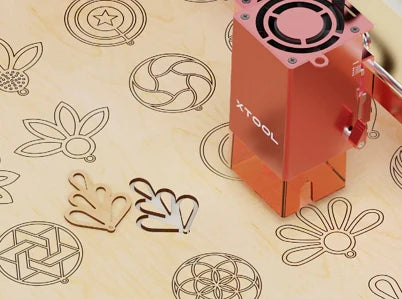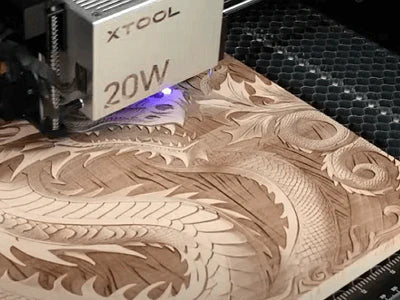How to Etch Acrylic? Step-by-Step Guide Here!
So you want to try etching/engraving on clear acrylic. Here is the process I worked up, which should at least get you in the ballpark. I don’t suggest following this exactly on something you have a client waiting on, use it as a starting point.

Items Needed for Acrylic Etching
1) Acrylic Sheets
Acrylic comes in two types - cast and extruded. Often, sellers don’t tell you what type it is, but, you’ll want the cast type whenever possible. Extruded is still workable, but is prone to fuzziness and bubbling/popping if hit with too much laser power. Some acrylic sheet, cutouts, or the like, ~3mm thick, to experiment on, will do the work.
2) Masking
Because you’re working with acrylic rather than glass, the type of masking used is more important. Paint removers that one would normally use on glass can/will damage the acrylic, making your time and effort a big waste.
For this reason, using a masking that is easy to remove is best. My personal preference is for water washable type masking. Examples include tempera paint, dry erase marker, magic marker/Sharpie, sidewalk chalk paint, and water color paint.
In this guide, I will be using tempera paint, but the steps are all generally the same.
Whatever masking you decide on, its color matters, as that color will be transferred to the acrylic permanently. Darker colors work best, while white is the most difficult (it absorbs the light from the laser).
If you’re planning to use an LED base to display your finished piece, this won’t matter much, as the LED color will override whatever color is on there for the most part.
Doing a single sided etching work just fine, especially if the intention is to backfill with color. Double sided gives more depth, a nice effect for photos. The only difference between the two in terms of process is that you don’t mask both sides for a single sided etching.
Preparations Before the Acrylic Etching
1) Preparing the paint
What I found works best for tempera paint is mixing it 3:1 with water. This gets it to a good consistency for airbrushing. Maybe for brushing/rolling too, but I haven’t tried the diluted method.
Why airbrush? Because frankly, I’m horrible at putting down nice smooth even coats of paint with a brush, and rollers are too bulky. An airbrush lets me spray the same as if I was using a rattle can, and the paint will dry quickly.
Having uneven coats results in an uneven etching, some areas being much lighter or missing entirely. This can be to your advantage though if you want to create some sort of effect around the edges.
2) Preparing the acrylic
First thing first, peel off the protective backing on one side. Paint that side, getting each coat as smooth and even as you can. Keep adding coats, until the acrylic is opaque.
Tracking how many coats you do will help if you’re doing a double-sided etching - you’ll know how many to put on the other side.
For single-sided etching, once the paint is all dry, you’re done. You can check your work by holding the acrylic up to the light.
Areas you can see light through don’t have as much paint as the rest, so you could try to even it out. Double-sided folks, do that same check. Then, peel the protective sheet off the other side and repeat the painting process on that side.
3) Preparing the image
Regardless of what you’re etching on, image preparation is important. Your image should be sized to match your material, DPI set to match what your laser engraver can do (or looks best), and processed so that it’s laser ready.
Even better, processed to match the material. There are a lot of different ways to do this, so you’ll have to choose what you like.
Both xTool Creative Space and Lightburn have the common processing algorithms as well as some tools for manipulating the image. Lightburn has a more extensive collection, but doesn’t do it all either.
I tend to use Imag-R, which is a free online processor with several specialized processing algorithms and other tools like background removal. It’s easy to set the size, DPI, material, etc for an image, and, you get a nice preview of what it should look like.
I’ve found that a DPI of 254 looks better than 318 (what the laser is capable of), but your mileage may vary. This equates to 0.1 line interval.
4) Preparing to etch
Prep all done, take your piece to the laser. You’ll want to elevate the piece at least a little bit, so that the bottom side is not touching anything aside from what you’re using to keep it aloft.
We do this because you don’t want the laser to pass through the acrylic, heat the surface below, which in turn melts your acrylic further than intended, or causes stains. (There is a technique for utilizing that, which I’ll cover in the Extra Credit section.)
Honeycomb users, this includes you. The acrylic should only be touching something in spots where engraving will not be taking place. Because the bed of my engraver is sheet steel, there is also a problem of reflecting. So, elevate, maybe 5mm or so (¼”). Little pegs, some pencils, etc.
5) Settings for acrylic etching
Generally speaking, you want to move the laser quickly across the acrylic with a low to medium power level. Remember, whatever you etch is what will show up. So, for photos, you want to make a negative image. This etches the lights instead of the darks in your photo, making it viewable at any angle rather than needing a reflection from the front.
The speed that works best for darker masking color is 3000mm/m, coupled with a power level of 30%, single pass. You can do more passes, but the effect lessens rapidly because the acrylic is no longer clear - the laser doesn’t go directly from top to bottom anymore. Learn more on xTool material settings.
Etch Acrylic Now
1) Etch
Once you’re all ready, kick off the job and wait. While waiting, observe. If you hear pops and clicks, chances are your power is too high and/or the acrylic is yucky. With safety goggles on, try to look at the bed of your engraver, under the acrylic.
If you see the laser hitting the bed, you’re in good shape. If it’s not, then your power is too low for the speed you’re running at. When the job finishes, let the acrylic cool for a few minutes before messing with it.
2) Finish
If you used tempera paint or sidewalk chalk paint, go wash the piece with warm (not hot) water to get rid of the masking. If you used dry erase marker, wipe off the excess. Should you have used Shapie/magic marker, IPA will help, though you can also use a dry erase marker (yes, dry erase marker will clean up permanent marker).
Extra Credit
A method to etch without paint and keeping the acrylic flat on the bed - put a sheet of colored paper on the bed and lay the acrylic on it. Run the same speeds as with paint, see where it gets you. This does work, but I found the resulting piece to be too light for my tastes.




